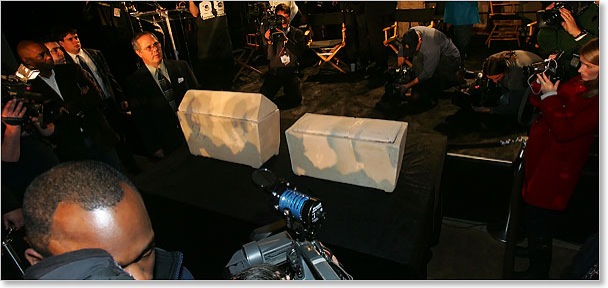More Thoughts on Cameron's "Jesus' Family Tomb"
02/27/2007 16:19 Filed in: Faith & Reason

From Larry:
It may be the case that Israel Antiquities Authority acted incorrectly in this case -- I don't feel I have enough information from the article to judge. I don't regard Biblical Archeology Review as a very careful journal, and I do note that expert witnesses in court trials tend to always make statements that agree with the side that retained them (if only because experts who don't agree with the lawyers are never put on the stand.) I don't think we can exclude the possibility of a careful forgery; certainly this would not be the first case.
On a more substantive note, based on the New York Times article today it appears that the main evidence presented by the filmmakers is the improbability of the names appearing together in the crypt. The article mentions the estimate of the chances of the names appearing together in the tomb are one in 600, based on an analysis by Andrey Feuerverger. I wonder if this doesn't reflect some statistical error. For example, there are presumably a number of ossuaries, both known and unknown, in the greater Jerusalem region. The NY Times article mentions that thousands of of ossuaries have been discovered.
Second, depending on how the problem was posed to the Feuerverger, the statistic may be quite misleading. A moment's thought reveals that there are many possible different configurations of names that could potentially "match" a potential family for Jesus. Thus, the actually probability of a ossuary having a set of names that match a purported Jesus family is perhaps far more likely than mentioned. Of course, we can't tell for sure without seeing Feuerverger's actual calculations, and to the best of my knowledge, he is not publishing those.
I did contact Feuerverger (whom I know) and he has not responded to my inquiries.
I am also struck by the fact that a $4 million budget film decided as a cost saving measure to limit the number of DNA samples tested. It raises suspicions.
Most damning of all is the quote by Kloner, which I repeat here:
Among the most influential scholars to dispute the documentary was Amos Kloner, former Jerusalem district archaeologist of the Israel Antiquities Authority, who examined the tomb in 1980.
Mr. Kloner said in a telephone interview that the inscription on the alleged “Jesus” ossuary is not clear enough to ascertain. The box on display at the news conference is a plain rectangle with rough gashes on one side. The one supposedly containing Mary Magdalene has six-petalled rosettes and an elaborate border.
“The new evidence is not serious, and I do not accept that it is connected to the family of Jesus,” said Mr. Kloner, who appears in the documentary as a skeptic.
Amos Kloner discovered the tomb, and you can read his report at the link given below. Kloner is a professor at Bar-Ilan (the Israeli equivalent of Yeshiva University) and has won the "Emet Prize" (truth prize) which includes a cash award of one million dollars from the Israeli government.
- Link to the NY Times article.
- Also check out Ben Witherington's take on the subject.









